check engine MAZDA MODEL 6 2008 (in English) User Guide
[x] Cancel search | Manufacturer: MAZDA, Model Year: 2008, Model line: MODEL 6, Model: MAZDA MODEL 6 2008Pages: 440, PDF Size: 6.49 MB
Page 167 of 440

Black plate (167,1)
If the light illuminates while driving:
1. Drive to the side of the road and parkoff the right-of-way on level ground.
2. Turn off the engine and wait 5 minutes for the oil to drain back into the oil
pan.
3. Inspect the engine oil level (page 8-19). If it's low, add oil.
4. Start the engine and check the warning light.
If the light remains illuminated even after
you add oil, stop the engine immediately
and have your vehicle towed to an
Authorized Mazda Dealer.
CAUTION
Don't run the engine if oil pressure is
low. It could result in extensive
engine damage.
q Check Engine Light
This indicator light illuminates when the
ignition switch is turned to the ON
position and goes off when the engine is
started.
If this light comes on while driving, the
vehicle may have a problem. It is
important to note the driving conditions
when the light came on and consult an
Authorized Mazda Dealer. The check engine light may come on in
the following cases:
lThe fuel tank level being very low or
approaching empty.
lThe engine's electrical system has a
problem.
lThe emission control system has a
problem.
lThe fuel-filler cap is missing or not
tightened securely.
If the check engine light remains on or
flashes continuously, do not drive at high
speeds and consult an Authorized Mazda
Dealer as soon as possible.
qAir Bag/Front Seat Belt
Pretensioner System Warning Light
If the air bag/front seat belt pretensioner
system is working properly, the warning
light illuminates when the ignition switch
is turned to the ON position or after the
engine is cranked. The warning light turns
off after a specified period of time.
A system malfunction is indicated if the
warning light constantly flashes,
constantly illuminates or does not
illuminate at all when the ignition switch
is turned to the ON position. If any of
these occur, consult an Authorized Mazda
Dealer as soon as possible. The system
may not work in an accident.
Driving Your Mazda
Warning/Indicator Lights and Beep Sounds
5-39
Mazda6_8X47-EA-07G_Edition1 Page167
Tuesday, May 29 2007 3:43 PM
Form No.8X47-EA-07G
Page 171 of 440

Black plate (171,1)
NOTElPerform tire pressure adjustment when the
tires are cold. Tire pressure will vary
according to the tire temperature, therefore
let the vehicle stand for 1 hour or only drive
it 1.6 km (1 mile) or less before adjusting
the tire pressures. When pressure is
adjusted on hot tires to the cold inflation
pressure, the TPMS warning light/beep may
turn on after the tires cool and pressure
drops below specification.
Also, an illuminated TPMS warning light,
resulting from the tire air pressure dropping
due to cold ambient temperature, may go
out if the ambient temperature rises. In this
case, it will also be necessary to adjust the
tire air pressures. If the TPMS warning
light illuminates due to a drop in tire air
pressure, make sure to check and adjust the
tire air pressures.
lAfter adjusting the tire air pressures, it may
require some time for the TPMS warning
light to go out. If the TPMS warning light
remains illuminated, drive the vehicle at a
speed of at least 25 km/h (16 mph) for 10
minutes, and then verify that it goes out.
lTires can loose a little air quite naturally
over time and the TPMS cannot tell if the
tires are getting too soft over time or you
have a flat. However, when you find one
low tire in a set of four - that is an
indication of trouble; you should have
someone drive the vehicle slowly forward
so you can inspect any low tire for cuts and
any metal sticking through tread or
sidewall. Put a few drops of water in the
valve stem to see if it bubbles indicating a
bad valve. Leaks need to be addressed by
more than simply refilling the trouble tire as
leaks are dangerous - take it to an
Authorized Mazda Dealer which has all the
equipment to fix tires, TPMS systems and
order the best replacement tire for your
vehicle.
If the warning light illuminates again even
after the tire pressures are adjusted, there
may be a tire puncture. Replace the
punctured tire with the temporary spare
tire (page 7-8).
NOTE
A tire pressure sensor is not installed to the
temporary spare tire. The warning light will
flash continuously while the temporary spare
tire is being used.
Warning light flashes
When the warning light flashes, there may
be a system malfunction. Consult an
Authorized Mazda Dealer.
qSecurity Indicator Light
This indicator light starts flashing every 2
seconds when the ignition switch is turned
from the ON to the ACC position and the
immobilizer system is armed.
The light stops flashing when the ignition
switch is turned to the ON position with
the correct ignition key.
At this time, the immobilizer system is
disarmed and the light illuminates for
about 3 seconds and then goes out.
If the engine doesn't start with the correct
ignition key, and the security indicator
light keeps illuminating or flashing, the
system may have a malfunction. Consult
an Authorized Mazda Dealer.
Driving Your Mazda
Warning/Indicator Lights and Beep Sounds
5-43
Mazda6_8X47-EA-07G_Edition1 Page171
Tuesday, May 29 2007 3:43 PM
Form No.8X47-EA-07G
Page 188 of 440
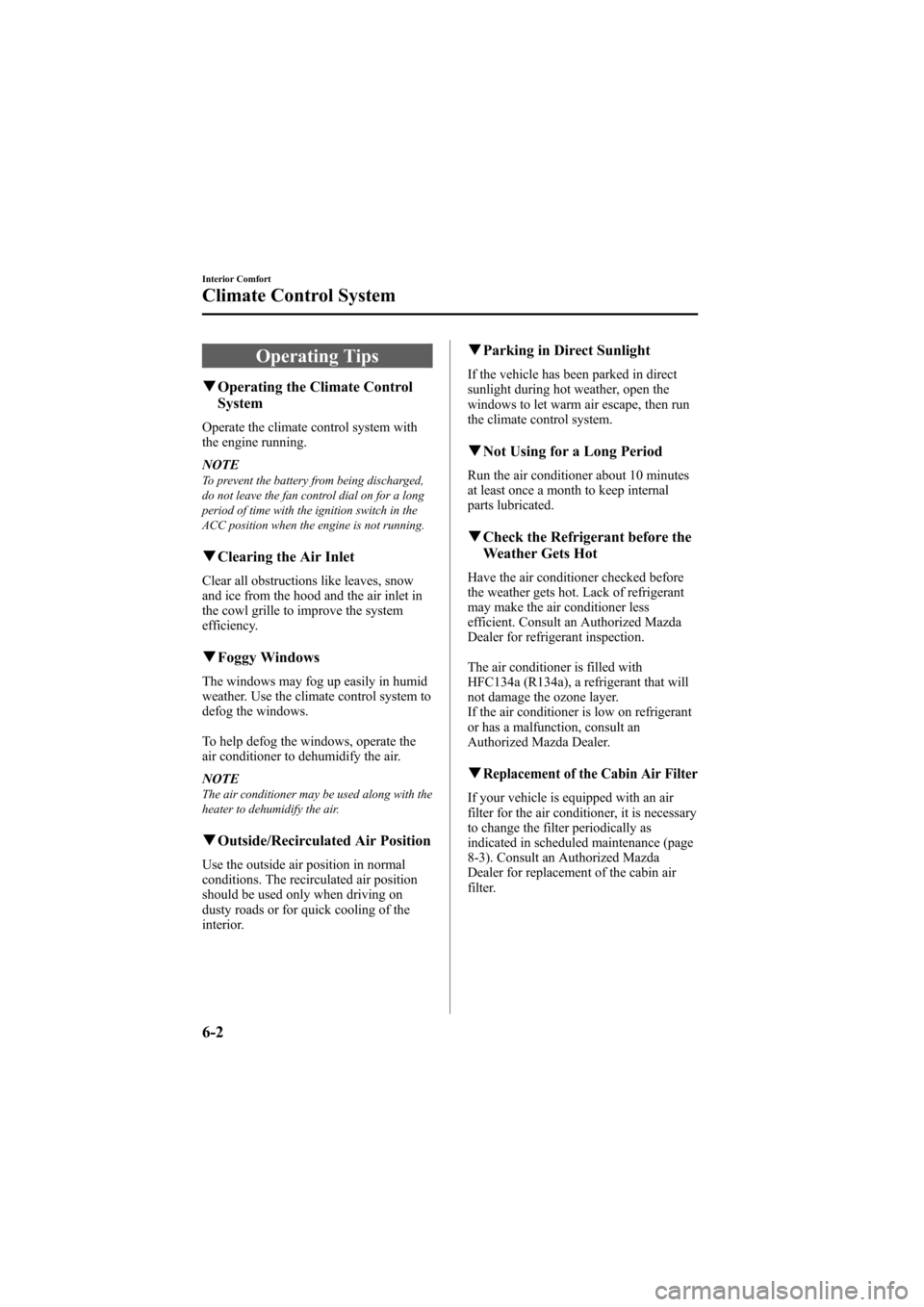
Black plate (188,1)
Operating Tips
qOperating the Climate Control
System
Operate the climate control system with
the engine running.
NOTE
To prevent the battery from being discharged,
do not leave the fan control dial on for a long
period of time with the ignition switch in the
ACC position when the engine is not running.
qClearing the Air Inlet
Clear all obstructions like leaves, snow
and ice from the hood and the air inlet in
the cowl grille to improve the system
efficiency.
qFoggy Windows
The windows may fog up easily in humid
weather. Use the climate control system to
defog the windows.
To help defog the windows, operate the
air conditioner to dehumidify the air.
NOTE
The air conditioner may be used along with the
heater to dehumidify the air.
qOutside/Recirculated Air Position
Use the outside air position in normal
conditions. The recirculated air position
should be used only when driving on
dusty roads or for quick cooling of the
interior.
qParking in Direct Sunlight
If the vehicle has been parked in direct
sunlight during hot weather, open the
windows to let warm air escape, then run
the climate control system.
qNot Using for a Long Period
Run the air conditioner about 10 minutes
at least once a month to keep internal
parts lubricated.
qCheck the Refrigerant before the
Weather Gets Hot
Have the air conditioner checked before
the weather gets hot. Lack of refrigerant
may make the air conditioner less
efficient. Consult an Authorized Mazda
Dealer for refrigerant inspection.
The air conditioner is filled with
HFC134a (R134a), a refrigerant that will
not damage the ozone layer.
If the air conditioner is low on refrigerant
or has a malfunction, consult an
Authorized Mazda Dealer.
qReplacement of the Cabin Air Filter
If your vehicle is equipped with an air
filter for the air conditioner, it is necessary
to change the filter periodically as
indicated in scheduled maintenance (page
8-3). Consult an Authorized Mazda
Dealer for replacement of the cabin air
filter.
6-2
Interior Comfort
Climate Control System
Mazda6_8X47-EA-07G_Edition1 Page188
Tuesday, May 29 2007 3:43 PM
Form No.8X47-EA-07G
Page 256 of 440
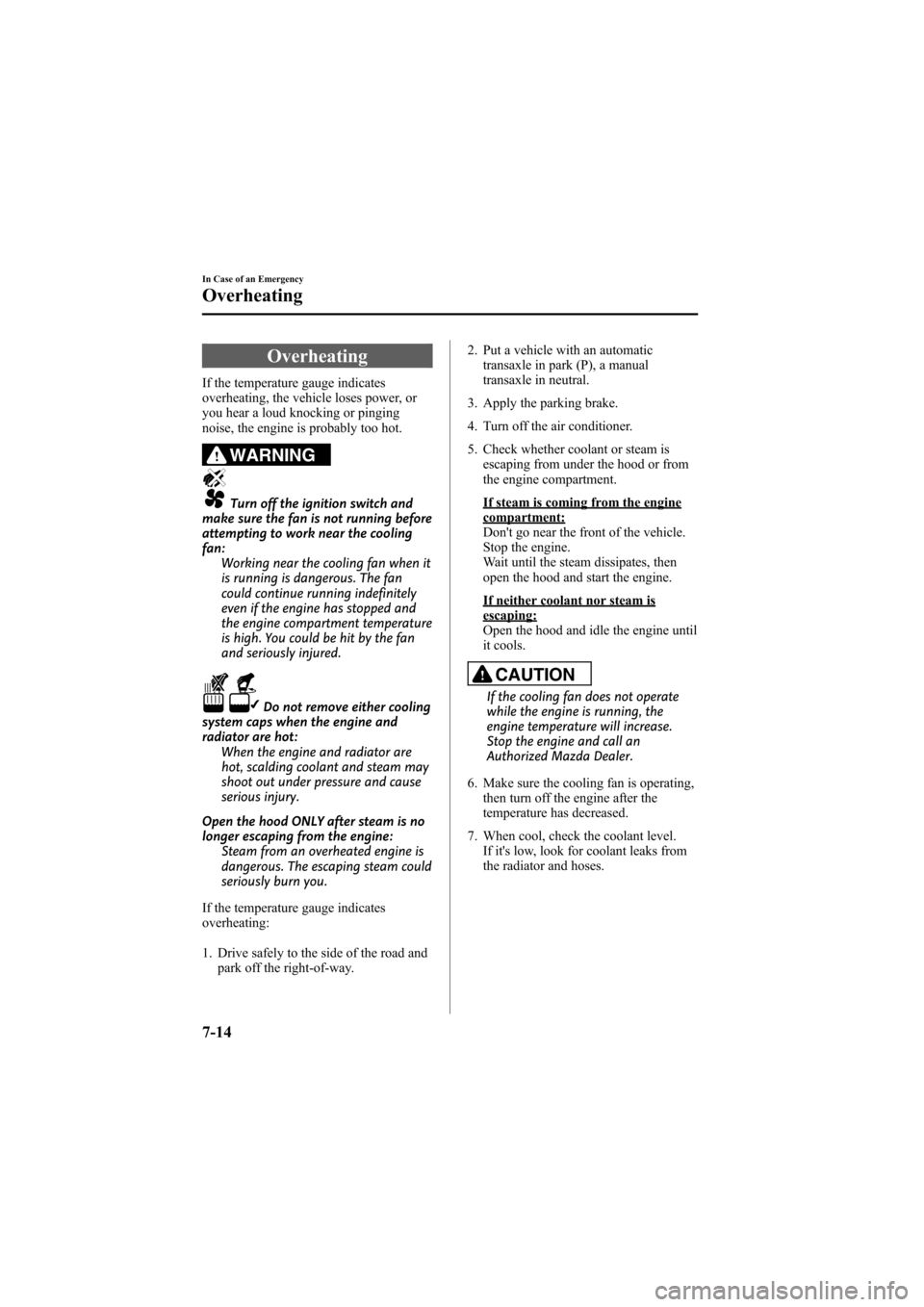
Black plate (256,1)
Overheating
If the temperature gauge indicates
overheating, the vehicle loses power, or
you hear a loud knocking or pinging
noise, the engine is probably too hot.
WARNING
Turn off the ignition switch and
make sure the fan is not running before
attempting to work near the cooling
fan: Working near the cooling fan when it
is running is dangerous. The fan
could continue running indefinitely
even if the engine has stopped and
the engine compartment temperature
is high. You could be hit by the fan
and seriously injured.
Do not remove either cooling
system caps when the engine and
radiator are hot: When the engine and radiator are
hot, scalding coolant and steam may
shoot out under pressure and cause
serious injury.
Open the hood ONLY after steam is no
longer escaping from the engine: Steam from an overheated engine is
dangerous. The escaping steam could
seriously burn you.
If the temperature gauge indicates
overheating:
1. Drive safely to the side of the road and park off the right-of-way. 2. Put a vehicle with an automatic
transaxle in park (P), a manual
transaxle in neutral.
3. Apply the parking brake.
4. Turn off the air conditioner.
5. Check whether coolant or steam is escaping from under the hood or from
the engine compartment.
If steam is coming from the enginecompartment:
Don't go near the front of the vehicle.
Stop the engine.
Wait until the steam dissipates, then
open the hood and start the engine.
If neither coolant nor steam isescaping:
Open the hood and idle the engine until
it cools.
CAUTION
If the cooling fan does not operate
while the engine is running, the
engine temperature will increase.
Stop the engine and call an
Authorized Mazda Dealer.
6. Make sure the cooling fan is operating, then turn off the engine after the
temperature has decreased.
7. When cool, check the coolant level. If it's low, look for coolant leaks from
the radiator and hoses.
7-14
In Case of an Emergency
Overheating
Mazda6_8X47-EA-07G_Edition1 Page256
Tuesday, May 29 2007 3:44 PM
Form No.8X47-EA-07G
Page 288 of 440

Black plate (288,1)
Automatic Transaxle Fluid
(ATF)
qInspecting Automatic Transaxle
Fluid Level
The automatic transaxle fluid level should
be inspected regularly. Measure it as
described below.
2.3-liter engine
CAUTION
Ø Always check the automatic
transaxle fluid level according to
the following procedure. If the
procedure is not done correctly,
the automatic transaxle fluid level
cannot be measured accurately
which could lead to automatic
transaxle damage.
Ø A low fluid level can cause
transaxle slippage. Overfilling can
cause foaming, loss of fluid, and
transaxle malfunction.
Ø Use only the specified fluid. A non-
specified fluid could result in
transaxle malfunction and failure.
1. Park on a level surface and set the parking brake firmly.
2. Make sure there is no ATF leakage from the ATF hose or the housing.
3. Shift the shift lever to the park position (P), start the engine and warm it up.
CAUTION
Do not shift the shift lever while the
engine is warming up. If the ATF level
is extremely low, the automatic
transaxle could be damaged. 4. While the engine is still idling, pull out
the dipstick and wipe it clean, and then
put it back.
5. Check the ATF level. If there is no ATF adhering 5 mm from the end of the
dipstick, add ATF.
CAUTION
If there is no ATF adhering to the
dipstick even after the engine has
been warmed up, do not drive the
vehicle. Otherwise, the automatic
transaxle could be damaged.
6. Shift the shift lever to each range and position, and make sure there is no
abnormality.
7. Drive the vehicle on city roads for 5 km (3.1 mile) or more.
8. Park on a level surface and set the parking brake firmly.
9. Shift the shift lever to the park position (P), check the ATF level while the
engine is idling, and make sure that the
ATF level is within the proper level. If
the ATF level is not within the proper
level, add ATF.
The proper fluid level is marked on the
dipstick as follows.
Low
Full
2.3-liter engine
8-24
Maintenance and Care
Owner Maintenance
Mazda6_8X47-EA-07G_Edition1 Page288
Tuesday, May 29 2007 3:44 PM
Form No.8X47-EA-07G
Page 289 of 440
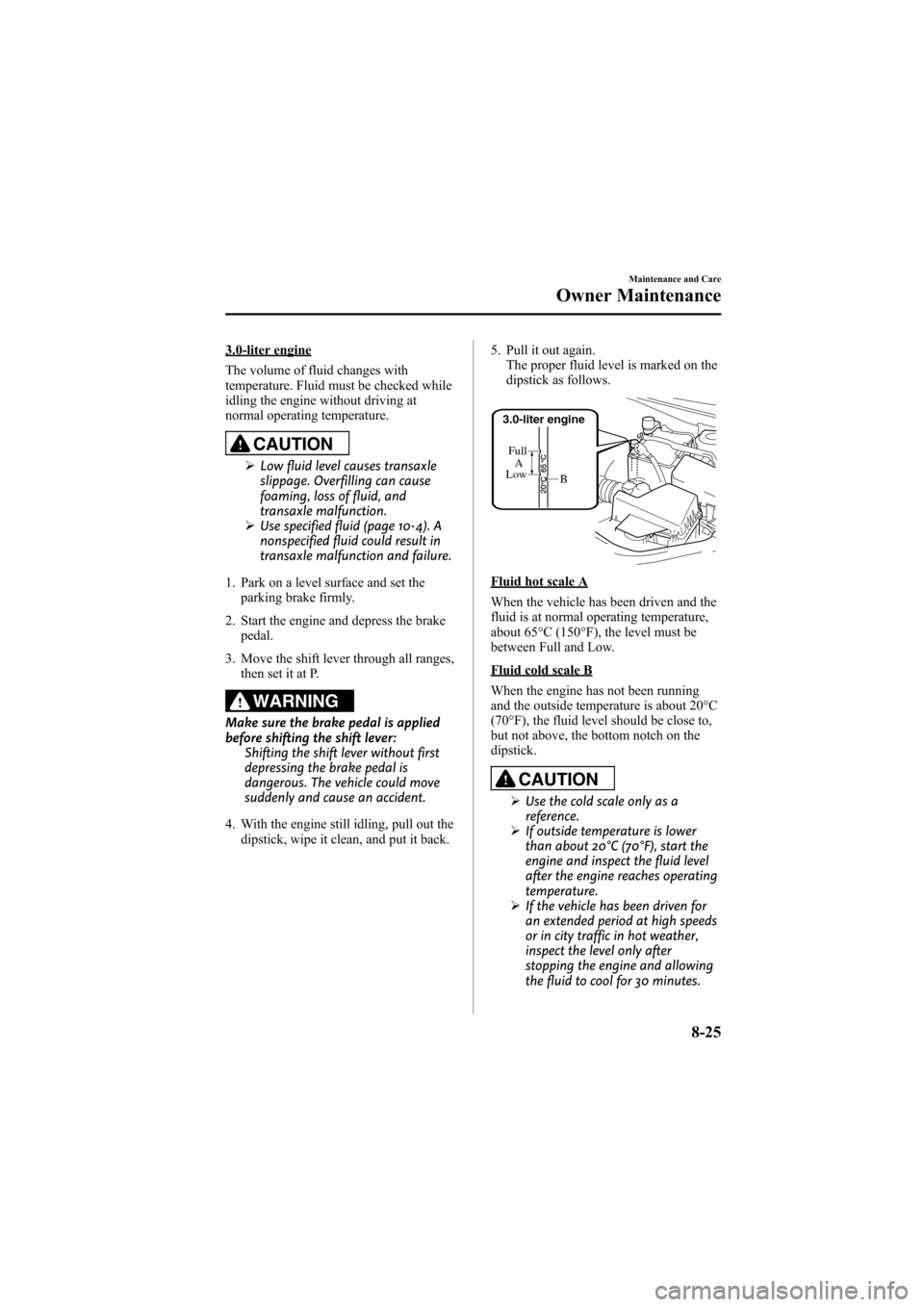
Black plate (289,1)
3.0-liter engine
The volume of fluid changes with
temperature. Fluid must be checked while
idling the engine without driving at
normal operating temperature.
CAUTION
ØLow fluid level causes transaxle
slippage. Overfilling can cause
foaming, loss of fluid, and
transaxle malfunction.
Ø Use specified fluid (page 10-4). A
nonspecified fluid could result in
transaxle malfunction and failure.
1. Park on a level surface and set the parking brake firmly.
2. Start the engine and depress the brake pedal.
3. Move the shift lever through all ranges, then set it at P.
WARNING
Make sure the brake pedal is applied
before shifting the shift lever: Shifting the shift lever without first
depressing the brake pedal is
dangerous. The vehicle could move
suddenly and cause an accident.
4. With the engine still idling, pull out the dipstick, wipe it clean, and put it back. 5. Pull it out again.
The proper fluid level is marked on the
dipstick as follows.
A
Full
B
Low
3.0-liter engine
Fluid hot scale A
When the vehicle has been driven and the
fluid is at normal operating temperature,
about 65°C (150°F), the level must be
between Full and Low.
Fluid cold scale B
When the engine has not been running
and the outside temperature is about 20°C
(70°F), the fluid level should be close to,
but not above, the bottom notch on the
dipstick.
CAUTION
Ø
Use the cold scale only as a
reference.
Ø If outside temperature is lower
than about 20°C (70°F), start the
engine and inspect the fluid level
after the engine reaches operating
temperature.
Ø If the vehicle has been driven for
an extended period at high speeds
or in city traffic in hot weather,
inspect the level only after
stopping the engine and allowing
the fluid to cool for 30 minutes.
Maintenance and Care
Owner Maintenance
8-25
Mazda6_8X47-EA-07G_Edition1 Page289
Tuesday, May 29 2007 3:44 PM
Form No.8X47-EA-07G
Page 371 of 440
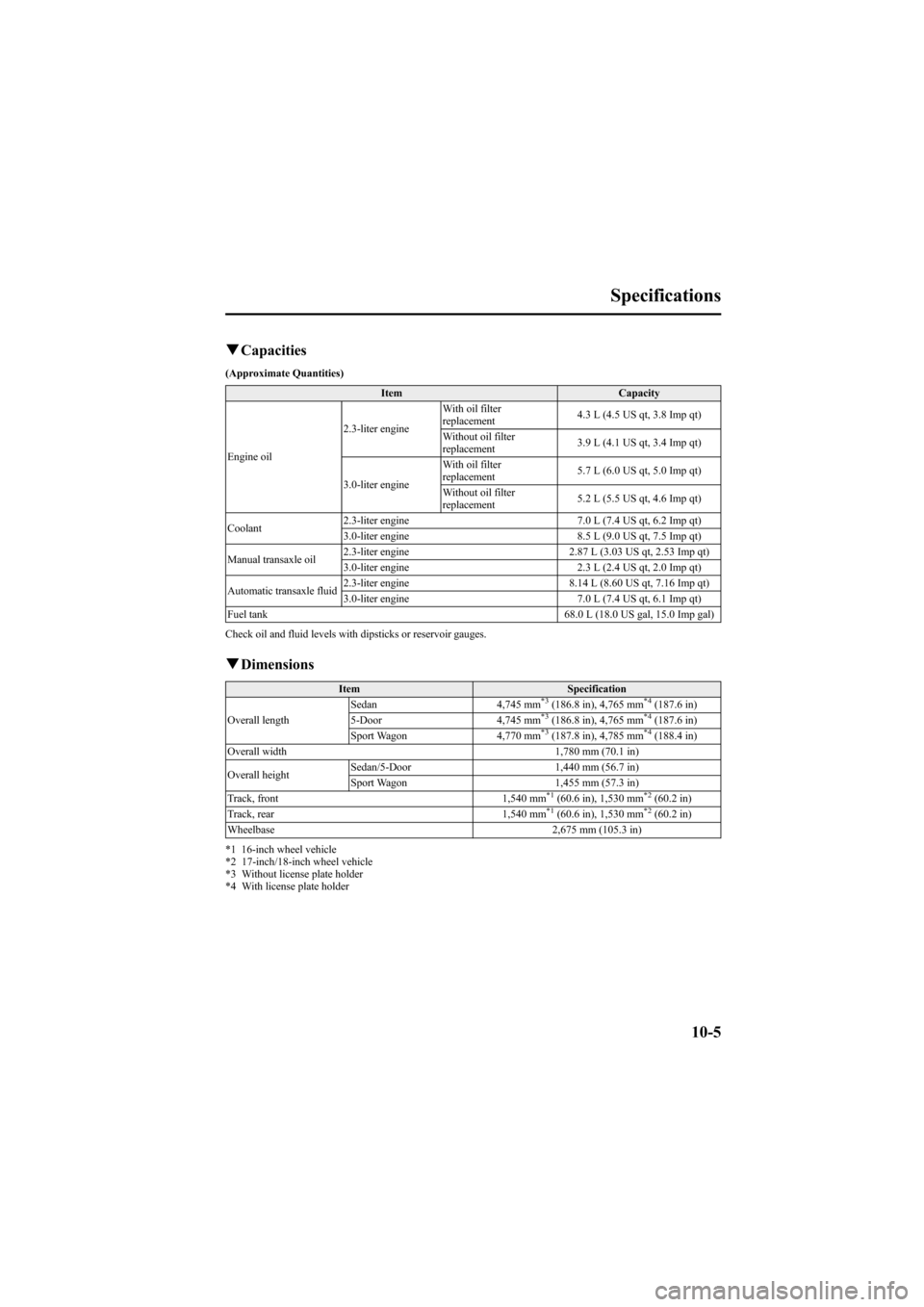
Black plate (371,1)
qCapacities
(Approximate Quantities)
Item Capacity
Engine oil 2.3-liter engine
With oil filter
replacement
4.3 L (4.5 US qt, 3.8 Imp qt)
Without oil filter
replacement 3.9 L (4.1 US qt, 3.4 Imp qt)
3.0-liter engine With oil filter
replacement
5.7 L (6.0 US qt, 5.0 Imp qt)
Without oil filter
replacement 5.2 L (5.5 US qt, 4.6 Imp qt)
Coolant 2.3-liter engine
7.0 L (7.4 US qt, 6.2 Imp qt)
3.0-liter engine 8.5 L (9.0 US qt, 7.5 Imp qt)
Manual transaxle oil 2.3-liter engine
2.87 L (3.03 US qt, 2.53 Imp qt)
3.0-liter engine 2.3 L (2.4 US qt, 2.0 Imp qt)
Automatic transaxle fluid 2.3-liter engine
8.14 L (8.60 US qt, 7.16 Imp qt)
3.0-liter engine 7.0 L (7.4 US qt, 6.1 Imp qt)
Fuel tank 68.0 L (18.0 US gal, 15.0 Imp gal)
Check oil and fluid levels with dipsticks or reservoir gauges.
q Dimensions
Item Specification
Overall length Sedan
4,745 mm*3(186.8 in), 4,765 mm*4(187.6 in)
5-Door 4,745 mm*3(186.8 in), 4,765 mm*4(187.6 in)
Sport Wagon 4,770 mm*3(187.8 in), 4,785 mm*4(188.4 in)
Overall width 1,780 mm (70.1 in)
Overall height Sedan/5-Door
1,440 mm (56.7 in)
Sport Wagon 1,455 mm (57.3 in)
Track, front 1,540 mm
*1(60.6 in), 1,530 mm*2(60.2 in)
Track, rear 1,540 mm*1(60.6 in), 1,530 mm*2(60.2 in)
Wheelbase 2,675 mm (105.3 in)
*1 16-inch wheel vehicle
*2 17-inch/18-inch wheel vehicle
*3 Without license plate holder
*4 With license plate holder
Specifications
10-5
Mazda6_8X47-EA-07G_Edition1 Page371
Tuesday, May 29 2007 3:45 PM
Form No.8X47-EA-07G
Page 380 of 440
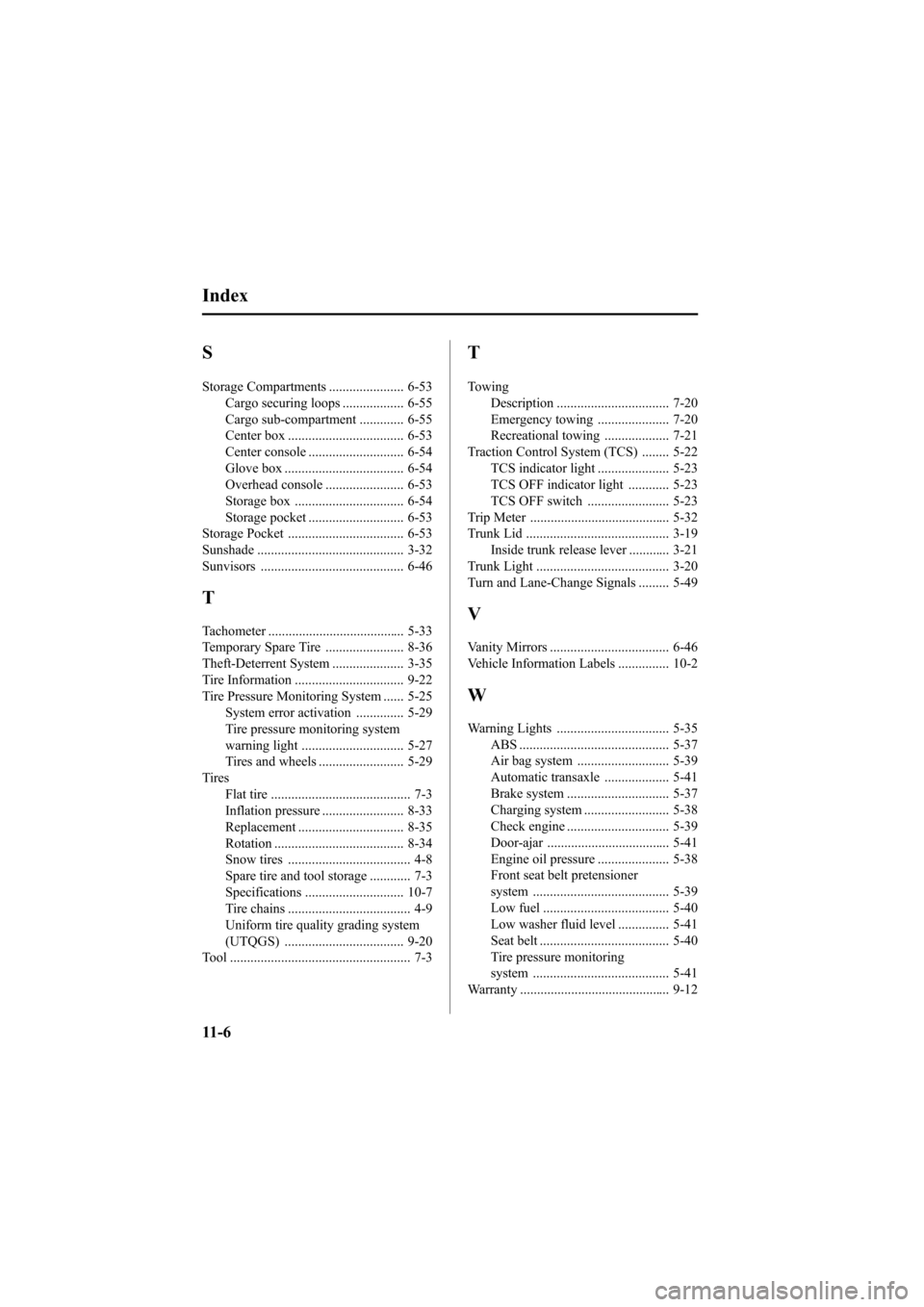
Black plate (380,1)
S
Storage Compartments ...................... 6-53Cargo securing loops .................. 6-55
Cargo sub-compartment ............. 6-55
Center box .................................. 6-53
Center console ............................ 6-54
Glove box ................................... 6-54
Overhead console ....................... 6-53
Storage box ................................ 6-54
Storage pocket ............................ 6-53
Storage Pocket .................................. 6-53
Sunshade ........................................... 3-32
Sunvisors .......................................... 6-46
T
Tachometer ........................................ 5-33
Temporary Spare Tire ....................... 8-36
Theft-Deterrent System ..................... 3-35
Tire Information ................................ 9-22
Tire Pressure Monitoring System ...... 5-25 System error activation .............. 5-29
Tire pressure monitoring system
warning light .............................. 5-27
Tires and wheels ......................... 5-29
Tires
Flat tire ......................................... 7-3
Inflation pressure ........................ 8-33
Replacement ............................... 8-35
Rotation ...................................... 8-34
Snow tires .................................... 4-8
Spare tire and tool storage ............ 7-3
Specifications ............................. 10-7
Tire chains .................................... 4-9
Uniform tire quality grading system
(UTQGS) ................................... 9-20
Tool ..................................................... 7-3
T
Towing Description ................................. 7-20
Emergency towing ..................... 7-20
Recreational towing ................... 7-21
Traction Control System (TCS) ........ 5-22 TCS indicator light ..................... 5-23
TCS OFF indicator light ............ 5-23
TCS OFF switch ........................ 5-23
Trip Meter ......................................... 5-32
Trunk Lid .......................................... 3-19 Inside trunk release lever ............ 3-21
Trunk Light ....................................... 3-20
Turn and Lane-Change Signals ......... 5-49
V
Vanity Mirrors ................................... 6-46
Vehicle Information Labels ............... 10-2
W
Warning Lights ................................. 5-35 ABS ............................................ 5-37
Air bag system ........................... 5-39
Automatic transaxle ................... 5-41
Brake system .............................. 5-37
Charging system ......................... 5-38
Check engine .............................. 5-39
Door-ajar .................................... 5-41
Engine oil pressure ..................... 5-38
Front seat belt pretensioner
system ........................................ 5-39
Low fuel ..................................... 5-40
Low washer fluid level ............... 5-41
Seat belt ...................................... 5-40
Tire pressure monitoring
system ........................................ 5-41
Warranty ............................................ 9-12
11-6
Index
Mazda6_8X47-EA-07G_Edition1 Page380
Tuesday, May 29 2007 3:45 PM
Form No.8X47-EA-07G